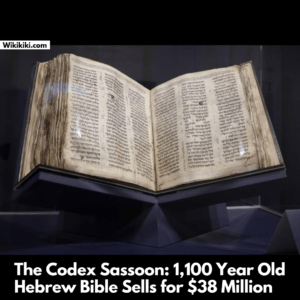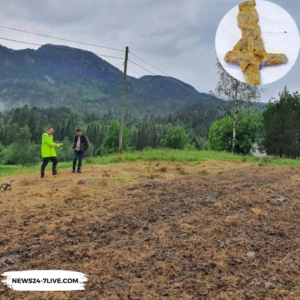The Codex Sassoon, a 1,100-year-old Hebrew Bible and one of the oldest surviving biblical manuscripts, was sold for $38 million at an auction in New York. The leather-bound parchment volume contains a nearly complete Hebrew Bible and was purchased by former U.S. Ambassador to Romania Alfred H. Moses on behalf of the American Friends of ANU. Moses then donated it to the ANU Museum of the Jewish People in Tel Aviv. The manuscript is believed to have been fabricated between 880 and 960 and is considered one of the highest prices ever paid for a manuscript at auction. Its sale reflects the significance and influence of the Hebrew Bible in human history.
Also Read: Saqqara Necropolis: Egypt Unveils Ancient Workshops and Tombs

In a historic moment for both the art and religious communities, a 1,100-year-old Hebrew Bible, known as the Codex Sassoon, was sold for an astounding $38 million at an auction held in New York. The leather-bound manuscript, believed to be from the 9th or 10th century, contains a nearly complete Hebrew Bible and is considered one of the oldest surviving biblical manuscripts in the world. The sale of the Codex Sassoon not only demonstrates the profound significance of the Hebrew Bible but also highlights its enduring power and influence as a pillar of humanity.
The Codex Sassoon
The Codex Sassoon, consisting of a handwritten parchment volume, is believed to have been created between the years 880 and 960. The manuscript contains a nearly complete Hebrew Bible, missing only about eight pages, and is written on 792 pages of sheepskin. Its writing and layout bear a resemblance to Torah scrolls used in synagogue services. As the world’s oldest nearly complete copy of the Hebrew Bible, the Codex Sassoon holds immense historical and religious significance. Its existence bridges the gap between the Dead Sea Scrolls, dating back to the third century BC, and the modern accepted form of the Hebrew Bible.
Origins
The manuscript was given its name in 1929 when it was purchased by David Solomon Sassoon, the son of an Iraqi Jewish business magnate known for his extensive collection of Jewish manuscripts. After David Sassoon’s passing, his estate was dispersed, and the Codex Sassoon was sold by Sotheby’s in Zurich in 1978 to the British Rail Pension Fund for approximately $320,000. The pension fund later sold the manuscript to Swiss financier and collector Jacqui Safra in 1989 for $3.19 million. Safra’s decision to sell the Codex Sassoon generated speculation about its future and whether it would end up in a public institution or a private collection.
Also Read: Mona Lisa Painting: Italian Historian Solved the Mystery of the Bridge
For over three decades, the Codex Sassoon remained relatively hidden from the public eye. However, in recent years, efforts were made to share its remarkable significance with the world. The manuscript embarked on a worldwide tour, captivating audiences as it was exhibited in various locations. Its presence at the ANU Museum in Tel Aviv garnered widespread attention and acclaim. Visitors marveled at its ancient beauty and historical importance.
Auction and the Record-Breaking Sale
In May 2023, the Codex Sassoon took center stage at a highly anticipated auction in New York. Bidders, both present at the venue and participating by phone, vied for the privilege of owning this extraordinary manuscript. The auction, lasting less than six minutes, witnessed a captivating bidding battle. In the end, former U.S. Ambassador to Romania Alfred H. Moses secured the codex on behalf of the American Friends of ANU. The final price, including fees and premiums, amounted to a staggering $38 million, solidifying its place as one of the most expensive manuscripts ever sold.
The $38 million price tag of the Codex Sassoon makes it one of the highest-priced manuscripts ever sold at auction. In 2021, a rare copy of the U.S. Constitution’s final text sold for $43 million, becoming the most expensive historical document ever sold. Leonardo da Vinci’s Codex Leicester holds the record for the most expensive hand-written document sold at auction, fetching $31 million in 1994 (equivalent to approximately $60 million today). The sale of the Codex Sassoon further reinforces the profound significance and value attributed to historic manuscripts and documents.
The Codex Sassoon in Context
When considering the significance of the Codex Sassoon, it is worth noting its place among other iconic historical documents. While the sale of the codex for $38 million is undoubtedly impressive, it falls short of the $43.2 million paid for a rare copy of the U.S. Constitution’s final text in 2021. Leonardo da Vinci’s Codex Leicester, with its scientific musings and drawings, fetched a staggering $30.8 million in 1994. These examples highlight the enduring fascination and value placed on historical manuscripts.
Also Read: New Dinosaur Species Reveals Clues about Spinosaurus History
Beyond its financial worth, the Codex Sassoon holds immense cultural and religious significance. It provides a tangible link to the past, offering insights into the language, script, and religious practices of ancient Jewish communities. The meticulous craftsmanship and attention to detail in its creation demonstrate the reverence with which the Hebrew Bible was regarded.
Scholars and researchers eagerly await the opportunity to study the Codex Sassoon up close. Its unique features and textual variations could shed light on the evolution of the Hebrew Bible and its transmission throughout the centuries. The codex also presents an opportunity to explore the cultural and historical context in which it was produced, providing valuable insights into Jewish life during the medieval period.
The acquisition of the Codex Sassoon by the ANU Museum of the Jewish People in Tel Aviv ensures its preservation, scholarly study, and public accessibility. The museum has a long-standing commitment to preserving and showcasing Jewish heritage and artifacts. The addition of the codex to its collection further solidifies its reputation as a premier institution for Jewish cultural studies.
The impact of the Codex Sassoon extends beyond academia. It serves as a symbol of cultural pride and identity for Jewish communities worldwide. Its public display at the ANU Museum will undoubtedly attract visitors from all walks of life, fostering a deeper understanding and appreciation of Jewish history and the sacred texts that have shaped it.
The Codex Sassoon stands as an extraordinary testament to the enduring significance of the Hebrew Bible and the cultural heritage it represents. Its recent sale for a record-breaking sum highlights the continued fascination with ancient manuscripts and the power of religious texts to transcend time. As it finds its new home at the ANU Museum of the Jewish People, the Codex Sassoon will continue to inspire awe and captivate audiences, ensuring its legacy endures for generations to come.
Also Read: The 2,000-Year-Old Roman Carvings Discovered in Spain



















+ There are no comments
Add yours